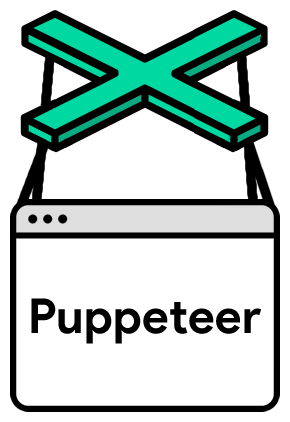What is puppeteer?
Puppeteer is a Node library which provides a high-level API to control Chrome or Chromium over the DevTools Protocol. It is primarily used for automating web browser actions, such as taking screenshots, generating pre-rendered content, and automating form submissions, among other things.
What are puppeteer's main functionalities?
Web Scraping
Puppeteer can be used to scrape content from web pages by programmatically navigating to the page and extracting the required data.
const puppeteer = require('puppeteer');
(async () => {
const browser = await puppeteer.launch();
const page = await browser.newPage();
await page.goto('https://example.com');
const data = await page.evaluate(() => document.querySelector('*').outerHTML);
console.log(data);
await browser.close();
})();
Automated Testing
Puppeteer can automate form submissions and simulate user actions for testing web applications.
const puppeteer = require('puppeteer');
(async () => {
const browser = await puppeteer.launch();
const page = await browser.newPage();
await page.goto('https://example.com/login');
await page.type('#username', 'user');
await page.type('#password', 'pass');
await page.click('#submit');
// Check for successful login
await page.waitForSelector('#logout');
await browser.close();
})();
PDF Generation
Puppeteer can generate PDFs from web pages, which is useful for creating reports, invoices, and other printable documents.
const puppeteer = require('puppeteer');
(async () => {
const browser = await puppeteer.launch();
const page = await browser.newPage();
await page.goto('https://example.com', {waitUntil: 'networkidle2'});
await page.pdf({path: 'example.pdf', format: 'A4'});
await browser.close();
})();
Screenshot Capture
Puppeteer can take screenshots of web pages, either of the full page or specific elements, which is useful for capturing the state of a page for documentation or testing.
const puppeteer = require('puppeteer');
(async () => {
const browser = await puppeteer.launch();
const page = await browser.newPage();
await page.goto('https://example.com');
await page.screenshot({path: 'example.png'});
await browser.close();
})();
Other packages similar to puppeteer
playwright
Playwright is a Node library to automate the Chromium, WebKit, and Firefox browsers with a single API. It is similar to Puppeteer but adds support for multiple browser types and has additional features like network interception.
selenium-webdriver
Selenium WebDriver is one of the most well-known browser automation tools. It supports multiple browsers and languages, making it more versatile than Puppeteer, but it can be more complex to set up and slower in execution.
nightmare
Nightmare is a high-level browser automation library. It is simpler and has a more fluent API compared to Puppeteer, but it is less actively maintained and lacks some of the newer features that Puppeteer provides.
webdriverio
WebdriverIO is a custom implementation for selenium's W3C webdriver API. It is designed to be more accessible than the Selenium WebDriver and integrates well with modern web and mobile application testing practices.
Puppeteer 



Puppeteer is a Node library which provides a high-level API to control headless Chrome or Chromium over the DevTools Protocol. It can also be configured to use full (non-headless) Chrome or Chromium.
What can I do?
Most things that you can do manually in the browser can be done using Puppeteer! Here are a few examples to get you started:
- Generate screenshots and PDFs of pages.
- Crawl a SPA and generate pre-rendered content (i.e. "SSR").
- Scrape content from websites.
- Automate form submission, UI testing, keyboard input, etc.
- Create an up-to-date, automated testing environment. Run your tests directly in the latest version of Chrome using the latest JavaScript and browser features.
- Capture a timeline trace of your site to help diagnose performance issues.
Give it a spin: https://try-puppeteer.appspot.com/
Getting Started
Installation
Note: Puppeteer requires at least Node v6.4.0, but the examples below use async/await which is only supported in Node v7.6.0 or greater
To use Puppeteer in your project, run:
yarn add puppeteer
# or "npm i puppeteer"
Note: When you install Puppeteer, it downloads a recent version of Chromium (~71Mb Mac, ~90Mb Linux, ~110Mb Win) that is guaranteed to work with the API. To skip the download, see Environment variables.
Usage
Puppeteer will be familiar to people using other browser testing frameworks. You create an instance
of Browser, open pages, and then manipulate them with Puppeteer's API.
Example - navigating to https://example.com and saving a screenshot as example.png:
const puppeteer = require('puppeteer');
(async () => {
const browser = await puppeteer.launch();
const page = await browser.newPage();
await page.goto('https://example.com');
await page.screenshot({path: 'example.png'});
await browser.close();
})();
Puppeteer sets an initial page size to 800px x 600px, which defines the screenshot size. The page size can be customized with Page.setViewport().
Example - create a PDF.
const puppeteer = require('puppeteer');
(async () => {
const browser = await puppeteer.launch();
const page = await browser.newPage();
await page.goto('https://news.ycombinator.com', {waitUntil: 'networkidle2'});
await page.pdf({path: 'hn.pdf', format: 'A4'});
await browser.close();
})();
See Page.pdf() for more information about creating pdfs.
Example - evaluate script in the context of the page
const puppeteer = require('puppeteer');
(async () => {
const browser = await puppeteer.launch();
const page = await browser.newPage();
await page.goto('https://example.com');
const dimensions = await page.evaluate(() => {
return {
width: document.documentElement.clientWidth,
height: document.documentElement.clientHeight,
deviceScaleFactor: window.devicePixelRatio
};
});
console.log('Dimensions:', dimensions);
await browser.close();
})();
See Page.evaluate() for more information on evaluate and related methods like evaluateOnNewDocument and exposeFunction.
Default runtime settings
1. Uses Headless mode
Puppeteer launches Chromium in headless mode. To launch a full version of Chromium, set the 'headless' option when launching a browser:
const browser = await puppeteer.launch({headless: false});
2. Runs a bundled version of Chromium
By default, Puppeteer downloads and uses a specific version of Chromium so its API
is guaranteed to work out of the box. To use Puppeteer with a different version of Chrome or Chromium,
pass in the executable's path when creating a Browser instance:
const browser = await puppeteer.launch({executablePath: '/path/to/Chrome'});
See Puppeteer.launch() for more information.
See this article for a description
of the differences between Chromium and Chrome. This article describes some differences for Linux users.
3. Creates a fresh user profile
Puppeteer creates its own Chromium user profile which it cleans up on every run.
API Documentation
Explore the API documentation and examples to learn more.
Debugging tips
-
Turn off headless mode - sometimes it's useful to see what the browser is
displaying. Instead of launching in headless mode, launch a full version of
the browser using headless: false:
const browser = await puppeteer.launch({headless: false});
-
Slow it down - the slowMo option slows down Puppeteer operations by the
specified amount of milliseconds. It's another way to help see what's going on.
const browser = await puppeteer.launch({
headless: false,
slowMo: 250
});
-
Capture console output - You can listen for the console event.
This is also handy when debugging code in page.evaluate():
page.on('console', msg => console.log('PAGE LOG:', ...msg.args));
await page.evaluate(() => console.log(`url is ${location.href}`));
-
Enable verbose logging - All public API calls and internal protocol traffic
will be logged via the debug module under the puppeteer namespace.
env DEBUG="puppeteer:*" node script.js
env DEBUG="puppeteer:*,-puppeteer:protocol" node script.js
env DEBUG="puppeteer:session" node script.js
env DEBUG="puppeteer:mouse,puppeteer:keyboard" node script.js
env DEBUG="puppeteer:*" env DEBUG_COLORS=true node script.js 2>&1 | grep -v '"Network'
Contributing to Puppeteer
Check out contributing guide to get an overview of Puppeteer development.
FAQ
Q: Which Chromium version does Puppeteer use?
Look for chromium_revision in package.json.
Puppeteer bundles Chromium to ensure that the latest features it uses are guaranteed to be available. As the DevTools protocol and browser improve over time, Puppeteer will be updated to depend on newer versions of Chromium.
Q: What is the difference between Puppeteer, Selenium / WebDriver, and PhantomJS?
Selenium / WebDriver is a well-established cross-browser API that is useful for testing cross-browser support.
Puppeteer works only with Chromium or Chrome. However, many teams only run unit tests with a single browser (e.g. PhantomJS). In non-testing use cases, Puppeteer provides a powerful but simple API because it's only targeting one browser that enables you to rapidly develop automation scripts.
Puppeteer bundles the latest versions of Chromium.
Q: Who maintains Puppeteer?
The Chrome DevTools team maintains the library, but we'd love your help and expertise on the project!
See Contributing.
Q: Why is the Chrome team building Puppeteer?
The goals of the project are simple:
- Provide a slim, canonical library that highlights the capabilities of the DevTools Protocol.
- Provide a reference implementation for similar testing libraries. Eventually, these
other frameworks could adopt Puppeteer as their foundational layer.
- Grow the adoption of headless/automated browser testing.
- Help dogfood new DevTools Protocol features...and catch bugs!
- Learn more about the pain points of automated browser testing and help fill those gaps.
Q: How does Puppeteer compare with other headless Chrome projects?
The past few months have brought several new libraries for automating headless Chrome. As the team authoring the underlying DevTools Protocol, we're excited to witness and support this flourishing ecosystem.
We've reached out to a number of these projects to see if there are opportunities for collaboration, and we're happy to do what we can to help.
Q: What features does Puppeteer not support?
You may find that Puppeteer does not behave as expected when controlling pages that incorporate audio and video. (For example, video playback/screenshots is likely to fail.) There are two reasons for this:
- Puppeteer is bundled with Chromium--not Chrome--and so by default, it inherits all of Chromium's media-related limitations. This means that Puppeteer does not support licensed formats such as AAC or H.264. (However, it is possible to force Puppeteer to use a separately-installed version Chrome instead of Chromium via the
executablePath option to puppeteer.launch. You should only use this configuration if you need an official release of Chrome that supports these media formats.) - Since Puppeteer (in all configurations) controls a desktop version of Chromium/Chrome, features that are only supported by the mobile version of Chrome are not supported. This means that Puppeteer does not support HTTP Live Streaming (HLS).







